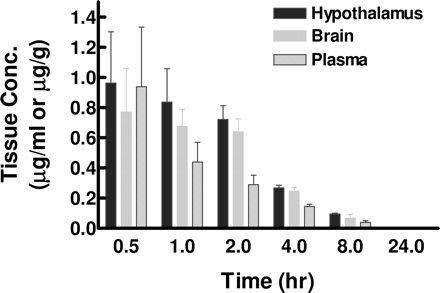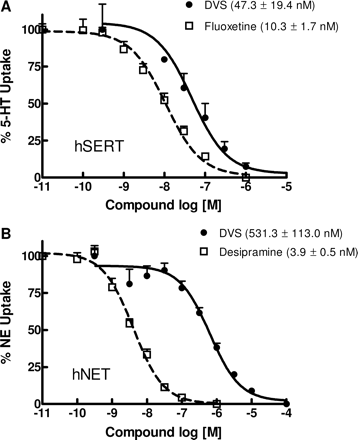
| Size | Price | Stock | Qty |
|---|---|---|---|
| 10mg |
|
||
| 25mg |
|
||
| 50mg |
|
||
| 100mg |
|
||
| 250mg |
|
||
| 500mg |
|
||
| 1g |
|
||
| Other Sizes |
Purity: ≥98%
Desvenlafaxine Succinate (formerly WY45233; WY 45233; O-desmethylvenlafaxine; trade name Pristiq, Desfax), the succinate salt of Desvenlafaxine which is an approved antidepressant drug, is a novel and potent serotonin (5-HT) transporter and norepinephrine (NE) transporter reuptake inhibitor with Ki of 40.2 nM and 558.4 nM respectively. The active metabolite of the antidepressant venlafaxine, which is marketed under the trade names Effexor and Efexor, is called desvenlafaxine. Like venlafaxine, desvenlafaxine blocks serotonin and norepinephrine from being absorbed by neurons. The human dopamine (DA) transporter exhibits a weak binding affinity (62% inhibition at 100 μM) for desvenlafaxine. Desvenlafaxine is being targeted as the first non-hormonal based treatment for menopause.
| Targets |
hSERT ( IC50 = 47.3 nM ); hNET ( IC50 = 531.3 nM )
|
||
|---|---|---|---|
| ln Vitro |
|
||
| ln Vivo |
|
||
| Animal Protocol |
|
||
| References | |||
| Additional Infomation |
A cyclohexanol and phenol derivative and metabolite of venlafaxine that functions as a SEROTONIN AND NORADRENALINE REUPTAKE INHIBITOR (SNRI) and is used as an ANTIDEPRESSIVE AGENT.
See also: Desvenlafaxine Succinate (annotation moved to). |
| Molecular Formula |
C20H31NO6
|
|
|---|---|---|
| Molecular Weight |
381.46
|
|
| Exact Mass |
381.215
|
|
| CAS # |
448904-47-0
|
|
| Related CAS # |
Desvenlafaxine; 93413-62-8; Desvenlafaxine succinate hydrate; 386750-22-7; Desvenlafaxine fumarate; 93414-04-1
|
|
| PubChem CID |
9800068
|
|
| Appearance |
Typically exists as solid at room temperature
|
|
| LogP |
2.668
|
|
| Hydrogen Bond Donor Count |
4
|
|
| Hydrogen Bond Acceptor Count |
7
|
|
| Rotatable Bond Count |
7
|
|
| Heavy Atom Count |
27
|
|
| Complexity |
359
|
|
| Defined Atom Stereocenter Count |
0
|
|
| SMILES |
CN(C)CC(C1=CC=C(C=C1)O)C2(CCCCC2)O.C(CC(=O)O)C(=O)O
|
|
| InChi Key |
ORUUBRMVQCKYHB-UHFFFAOYSA-N
|
|
| InChi Code |
InChI=1S/C16H25NO2.C4H6O4/c1-17(2)12-15(13-6-8-14(18)9-7-13)16(19)10-4-3-5-11-16;5-3(6)1-2-4(7)8/h6-9,15,18-19H,3-5,10-12H2,1-2H3;1-2H2,(H,5,6)(H,7,8)
|
|
| Chemical Name |
butanedioic acid;4-[2-(dimethylamino)-1-(1-hydroxycyclohexyl)ethyl]phenol
|
|
| Synonyms |
|
|
| HS Tariff Code |
2934.99.9001
|
|
| Storage |
Powder -20°C 3 years 4°C 2 years In solvent -80°C 6 months -20°C 1 month |
|
| Shipping Condition |
Room temperature (This product is stable at ambient temperature for a few days during ordinary shipping and time spent in Customs)
|
| Solubility (In Vitro) |
|
|||
|---|---|---|---|---|
| Solubility (In Vivo) |
|
| Preparing Stock Solutions | 1 mg | 5 mg | 10 mg | |
| 1 mM | 2.6215 mL | 13.1075 mL | 26.2151 mL | |
| 5 mM | 0.5243 mL | 2.6215 mL | 5.2430 mL | |
| 10 mM | 0.2622 mL | 1.3108 mL | 2.6215 mL |
*Note: Please select an appropriate solvent for the preparation of stock solution based on your experiment needs. For most products, DMSO can be used for preparing stock solutions (e.g. 5 mM, 10 mM, or 20 mM concentration); some products with high aqueous solubility may be dissolved in water directly. Solubility information is available at the above Solubility Data section. Once the stock solution is prepared, aliquot it to routine usage volumes and store at -20°C or -80°C. Avoid repeated freeze and thaw cycles.
Calculation results
Working concentration: mg/mL;
Method for preparing DMSO stock solution: mg drug pre-dissolved in μL DMSO (stock solution concentration mg/mL). Please contact us first if the concentration exceeds the DMSO solubility of the batch of drug.
Method for preparing in vivo formulation::Take μL DMSO stock solution, next add μL PEG300, mix and clarify, next addμL Tween 80, mix and clarify, next add μL ddH2O,mix and clarify.
(1) Please be sure that the solution is clear before the addition of next solvent. Dissolution methods like vortex, ultrasound or warming and heat may be used to aid dissolving.
(2) Be sure to add the solvent(s) in order.
| NCT Number | Recruitment | interventions | Conditions | Sponsor/Collaborators | Start Date | Phases |
| NCT00818155 | Completed | Drug: desvenlafaxine succinate SR Other: Placebo |
Healthy | Wyeth is now a wholly owned subsidiary of Pfizer |
January 2009 | Phase 1 |
| NCT01948895 | Completed | Drug: Desvenlafaxine | Dysthymic Disorder | Centre for Addiction and Mental Health |
August 2012 | Not Applicable |
| NCT01309542 | Completed | Drug: Desvenlafaxine Succinate | Major Depressive Disorder | Pfizer | August 2003 | Phase 3 |
| NCT00887224 | Completed | Drug: Placebo Drug: Desvenlafaxine succinate sustained release 50 mg |
Major Depressive Disorder | Pfizer | June 2009 | Phase 3 |
| NCT00683800 | Completed | Drug: Placebo Drug: desvenlafaxine succinate (DVS) SR |
Vasomotor Symptoms | Pfizer | June 2008 | Phase 3 |
|
|---|
|
  |